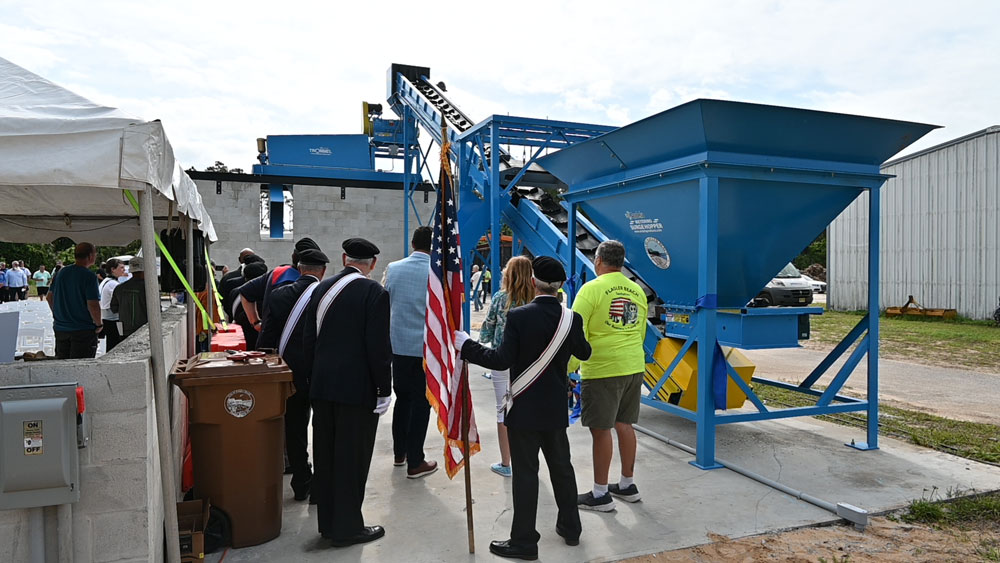
Unless it’s raising utility fees, buying expensive fire trucks or banning something on the beach, Flagler Beach government doesn’t generally draw many people to its events. But scores turned up Wednesday morning–at the city’s aromatically breezed sewer plant, of all places, to see the sanitation department’s new glass-crushing, glass-recycling machine in action after the sort of ribbon-cutting that attends the opening of roads, parks or big businesses.
Flagler Beach Mayor Suzie Johnston considered it “the largest turnout I think we have had at an event here in Flagler Beach probably besides the Holiday at the Beach” parade. And why not. Unique in Flagler or surrounding counties, the machine is giving Flagler Beach the capability to recycle its own glass, keep the resulting sand or glass pellets, recycle them in public works projects, or sell them to residents, generating the sort of revenue Sanitation Director Rob Smith hopes will pay for the machine’s maintenance, which won’t be cheap.
She recalled the budget sessions with her fellow city commissioners last summer, when the commission agreed to institute a $2-a-month recycling fee, raise trash fees slightly and buy the $200,000 glass-crushing machine, nick-named “Big Blue.”
“An amazing aspect of having our own glass recycling machine. Is that Flagler Beach residents can purchase this glass that big blue creates. And this means that the recycled glass can be 100 percent reused within our own community,” Johnston said.
After a blessing of the Blue by Rev. Manny Lopez of Santa Maria del Mar Catholic church (the machine is certifiably non-denominational and loves beer bottles), Smith turned it on for the demonstration. It wasn’t as loud as expected. Ear plugs that had been distributed to some were unnecessary, the machine producing the almost cathartic sound of sound of glass shattering back to dust.
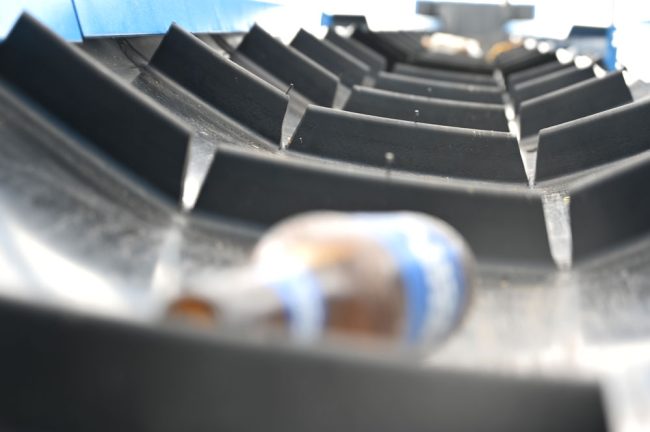
Nor was it a particularly absorbing sight: glass already partially smashed slowly made its way from a large hopper onto a conveyor belt that went through a sorter that freed it of metals, lids, paper. The rest passed through the actual crushers in two separate chambers, one of them reducing glass to the consistency of sand, the other to that of pellets. Both finished products snowed on the other side of a recently built cinder block wall and two subdivided sections. Take both pulverized products in your hand: you won’t feel a sharp edge anywhere.
Cell phones’ cameras whirred as the machine crushed it, even if champaign corks flew: the sense was that Flagler Beach was bringing back a little excitement to recycling, and more pointedly, bringing back a little more believability in it: many residents now take it for granted that recycling is more for appearances’ sake as haulers routinely dump recyclables with general trash, because it’s not worth the cost of sorting and recycling. For glass, anyway–the most perpetually recyclable product of them all, and the least polluting–that’s changing in Flagler Beach.
The machine can crush 3 to 5 tons an hour, though the city won’t do that much. It costs about $3.50 per ton for maintenance–greasing, replacing the 48 hammers that do the crushing–24 hammers in each crusher–and that sort of thing. All the recycling material will remain in the cinder block bins. Beverly Beach already wants 10,000 pounds. The city will sell only to residents of Flagler Beach and Beverly Beach, at around $2 a pound, or up to $50 for a 25 pound bag, less if the volume grows. Smith has no doubt “it will be work,” but he says he and his staff of 13, and their four garbage trucks, will get it done.
The demonstration attracted Bunnell’s sanitation director and sanitation men from St. Augustine Beach, though not from Palm Coast.
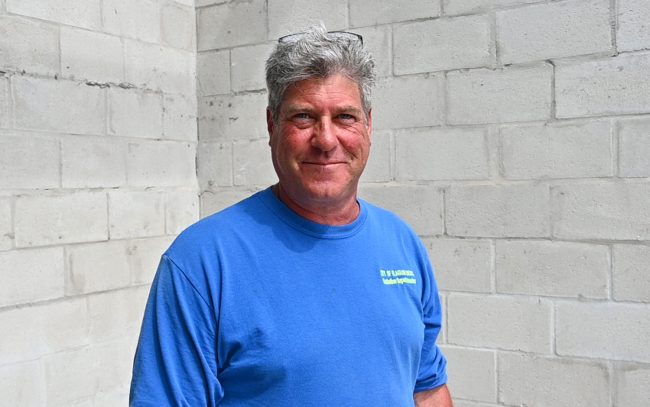
For Smith, it was like going from villain to hero just a year after he’d gone before the commission to propose (successfully) to end all recycling but for aluminum and certain cardboards. Why? “Because basically it turned into another trash day,” he said: the city couldn’t recycle most products anymore, not in a cost-effective way, so recyclables ended up at the dump anyway. Smith took a look of criticism from residents. ” I was not a very well liked person,” he recalled. But Smith, who thrives on the creative aspects of his job, came up with the idea of a glass-crusher, part of a long-term plan to start over on recycling.
“There’s 5500 folks in town, so it’s something that’s doable for our community. It’s nothing outrageous. It’s not crazy. It’s a way to use 100 percent of the material back inside the city limits.”
The sanded glass meets all the approved standards of the Florida Department of Transportation and the U.S. Corps of Engineers, Smith said. It can be used for landscaping, to fill potholes, to meet demands of public works projects, saving trucked-in costs for sand from elsewhere. It could be put on the beach. But that won’t happen in Flagler Beach, as it’ll be used elsewhere–and sold.
The city generates 12 to 14 tons of glass per week. By eliminating that weight from the dump in Bunnell, “it’s about $600, $700 a week just in tipping fees that go away, hours a week, just in tipping fees to go away. ” So do fuel costs to truck the tonnage to Bunnell.
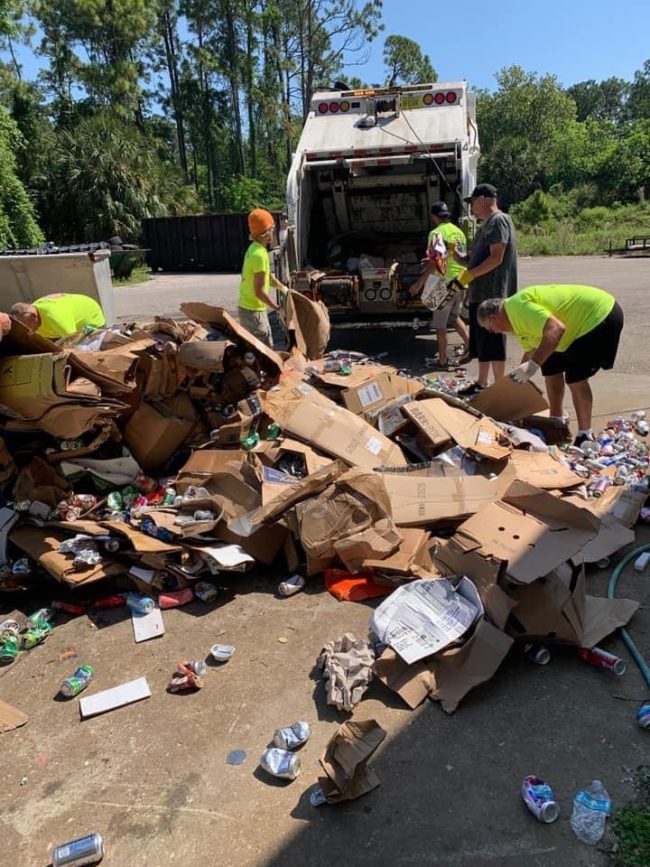
It can–and will be–used for landscaping, public works we use all the standards that have been sanded over the bridge from from outside sources they can use the sand the sand is FDA approved its army corps of engineers approved. They can use it for potholes. They can use them for you know, to be totally work.
“Rob is always one of those department heads that’s out there thinking, thinking about ways to improve things, ways to do things better,” City Manager William Whitson said. Smith approached Whitson soon after Whitson took over as city manager, about a year ago. “And he said, Hey, we need to get a glass recycling machine.” The city manager was intrigued. “We can we can remove a lot of weight out of the waste stream and lower our fuel usage and it’ll be awesome,” he said Smith told him.
City manager and commission cleared the way.
There was a subplot. An unlikely star of the morning’s ribbon-cutting was 13-year-old seventh-grader Jude Lisenby (a student at Connections Academy, the Florida virtual school), who, when Smith convinced the city commission to stop recycling, wrote the city manager of his disappointment. It started as a civics project requiring him to do something that would make a difference in his community. His family has been in Flagler Beach over 20 years.
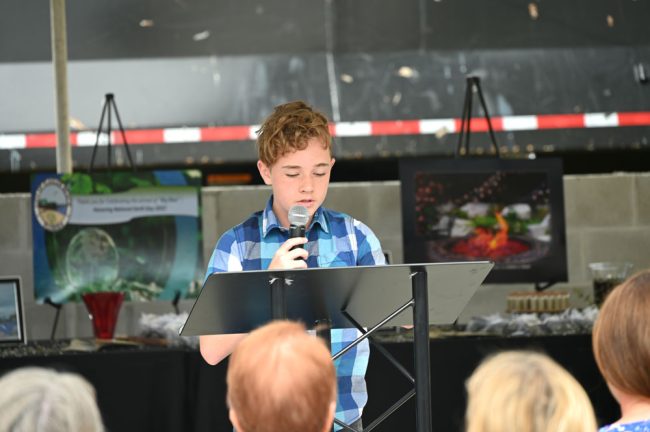
Whitson replied swiftly, and connected him with Smith. He met with Smith, who took Lisenby and his mother Dawn to get a look at the dump in Bunnell, “where our minds were blown,” Dawn Lisenby said, “because it’s kind of like people who eat meat and they don’t know how meat is processed. Same thing. You go out there, you realize, wow, and this is a week’s worth of trash.” Jude wanted to get involved in the city’s re-education process on recycling. He’s now the “Flagler Beach youth ambassador to help educate the public,” Dawn Lisenby said. (Jude is not only into competitive soccer: he plans on being a professional soccer player.)
“If they keep expanding the recycling program, I think that would be very good for the community,” Jude said. He also has his eyes on beach erosion (his family lives a block away from the beach). “I believe that Flagler Beach will become a model for other communities to restore their recycling programs as well,” he said at the conclusion of his speech to the sizeable crowd, conquering his shyness along the way.
“That’s that’s the goal,” Smith said, “to, at some point, have our own complete recycling center on site that we recycle 100 percent of our own products and we know where they’re going. I want to do plastic next. But I want to get a baler. I want to baler so I can do my aluminum, bale my own cardboard. It’s just work. It’s not rocket science. None of this is hard. It’s nothing exotic. It’s just getting the product and dealing with it. You know, we’re going to have a big facility at some point. There’s plenty of room here to do whatever we need to do, so it’s just work. Just work.”
![]()
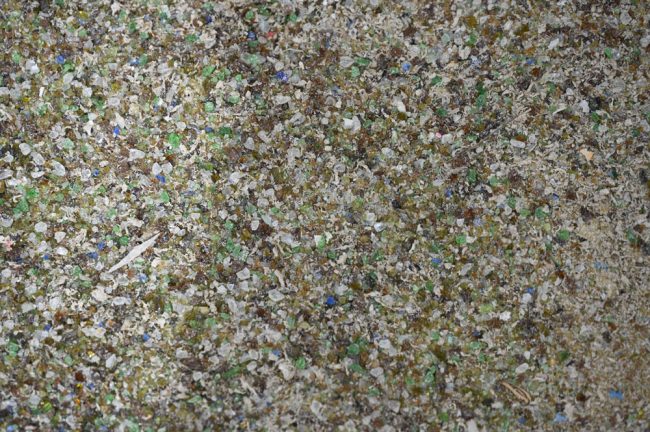





























FB Resident says
Thank you to the city of Flagler Beach and to Rob Smith that is always an innovative planner. A year of hard work has paid off.
Kathleen Brady says
I’m grateful to read this article and see how thinking outside the box is benefiting our community and our planet.
Sally says
When can we expect the city to start recycling glass again?
Keith Eckert says
I would love to purchase and use your recycled glass in my landscape. Please let me know how I can get this product. Thank you!
Lee Stewart says
I would definitely like to see your machine in action. I would like a pound of both grades of glass. My thinking is how can the pieces of glass be used in precast concrete, sidewalks ,footer, etc. I would like to assign the project to an engineering student to compare sand and cement, glass and cement and a mixture of sand/ glass and concrete to determine what is the strongest.
Perhaps you have already sent samples to concrete companies and have results that you can pass on to me. I will certain pass on to you our results. I will push this idea to Purdue and Ross Hulman Institute , both highly rated engineering universities. I am only a retired teacher who is very concerned about the dumping of glass in New Smyrna Beach.
Would you please give me a few minute of your time for a work in progress and some questions and your phone number?
sincerely ,
Lee Stewart 764-720-0140 or susan.lee.stewart @ gmail.com